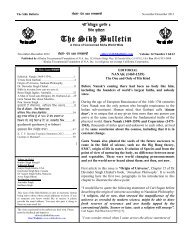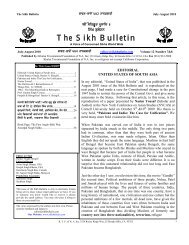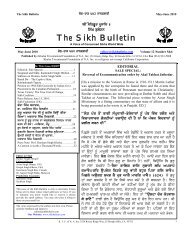Create successful ePaper yourself
Turn your PDF publications into a flip-book with our unique Google optimized e-Paper software.
<strong>The</strong> <strong>Sikh</strong> <strong>Bulletin</strong> cyq-vYswK 539 March-April 2007<br />
basically is to show the superiority of one blessed by the<br />
goddess over all the gods of the Hindu pantheon. <strong>The</strong> idea is<br />
that even servants of that goddess are capable of prevailing<br />
against gods and incarnations. Mughals and Muslims are<br />
thrown in to emphasise that the hero blessed by his deity is<br />
capable of defeating them whereas the Hindu gods and<br />
incarnations lay prostrate before the alien conquerors of<br />
Hind. This skewed rendering may very well have been<br />
inspired by the unproductive rage of the sensitive poets of<br />
Hind. Perhaps it was their feeling of gross inadequacy that<br />
had originally given rise to deities like Mahakal and<br />
Mahakali. <strong>The</strong>ir sentiment can be understood and even<br />
appreciated but it can hardly be applauded unreservedly.<br />
He shows often enough that he has no respect for Krishan<br />
whom he depicts, contrary to the writings of the original<br />
Srimadbhagwatpurana, (which he claims to be translating) as<br />
a drunkard (Ibid., p.604, couplet 1893 and swayia 1894). He<br />
is shown as distributing drugs to his entire army. <strong>The</strong>se drugs<br />
are the same as those that sakats use in their rituals. (Ibid.,<br />
p.734, swayia 2311) Krishan comes back after winning over<br />
the daughter of the king of Ayodhya and arranges<br />
celebrations in a pleasure garden. He sends for the favourite<br />
drugs of the sakats, that is poppy husk, opium, marijuana<br />
(Ibid., p.670, swayia 2112). To execute another ritual<br />
associated with the sakats, Krishan also asks many prostitutes<br />
to attend the celebration. (Ibid., p.672, swayia 2113) After he<br />
is high on drugs, Krishan remarks, ‘Brahma (the creator, in<br />
Hindu mythology) did not do well in this that he did not<br />
create the eighth ocean of alcohol.’ To this Arjun replies,<br />
‘that foolish Brahmin does not know how these delights are<br />
created.’ (Ibid., p. 672, swayia 2116)<br />
<strong>The</strong>re are several portions of the book which proceed from<br />
the acceptance of Durga as the ‘sexual energy’ and are<br />
written in celebration of that position. <strong>The</strong> Cheerharan<br />
chapter (‘clothes snatching episode’), ends with Krishan<br />
“knowing” the Gopis in the biblical sense. <strong>The</strong> episode is not<br />
so explicit in the original work. <strong>The</strong> Gopis praise Durga to<br />
render thanks and consider their achievement to be the result<br />
of Durga’s boon. (Ibid., p.98, swayias 281, 283-89). <strong>The</strong><br />
milkmaids of the original purana do not worship devi after<br />
this episode. This is particularly a shakat strain that is kept up<br />
in the rest of the book. In the characteristic sakat manner, the<br />
gopis defy social norms to bare their heads with abandon<br />
(Ibid., p. 153, swayia 450). <strong>The</strong> rest of their clothes and<br />
ornaments fall off on their own as they excitedly approach<br />
Krishan. (Ibid., p. 153, swayia 451) No philosophical<br />
explanation of the phenomena is offered by the author.<br />
On careful reading, this book reveals its true character as<br />
sakat interpretation of the popular Krishan legend. Gods for<br />
the sakat sect are Mahakali and Mahakal (who are considered<br />
essentially indistinguishable). Primary object of the<br />
Krishanavtar is to depict that the whole world revolves<br />
around these gods. <strong>The</strong> poet affirms, ‘I do not begin worship<br />
by acknowledging Ganesh and never meditate upon Kishan<br />
or Vishnu. I have heard of them but do not recognise them.’<br />
(Ibid., p.148, couplet 434) In the concluding phrase and in<br />
the next couplet (435), he affirms that he is the devotee of<br />
Mahakaal. <strong>The</strong>se and the other twenty or so often misquoted<br />
lines, do not indicate that the author is the devotee of Akal<br />
Purakh of <strong>Sikh</strong> conception. <strong>The</strong> Krishanavtar finally<br />
emerges as a piece of literature having origins in the sakat<br />
sect.<br />
Had Guru Gobind Singh written it and not owned the<br />
writing as his, it would tantamount to concealing his faith.<br />
In the earliest documents of <strong>Sikh</strong> history (namely the<br />
Janamsakhis) the Gurus demand that their followers openly<br />
repose faith in them. Contrary to the Indian spiritual<br />
tradition of concealing or restricting the religious<br />
instructions, they sing them openly in congregation, write<br />
them in commonly understood script and bar no people’s<br />
access to them. <strong>The</strong> <strong>Sikh</strong>s in return openly declare their faith<br />
in <strong>Sikh</strong>i. A phrase commonly used in this connection is,<br />
naam dharik sikh hoa (openly declared conversion to <strong>Sikh</strong>i).<br />
In concealing his faith, the Guru would also be violating the<br />
‘concept of open diplomacy’ which in a manner of speaking<br />
is one important pillar of the <strong>Sikh</strong> faith. Of this the Tenth<br />
Guru was the most prominent exponent. One expression of<br />
which was his creation of the Khalsa in 1699 in the form of<br />
an easily distinguishable person openly wedded to putting<br />
an end to tyranny of all kinds.<br />
On the moral plane, the abundance of promiscuous sexual<br />
activity, licentious behaviour of certain individuals, the free<br />
use of drugs and inducements offered for sexual favours<br />
(bringing certain acts within the purview of provisions for<br />
rape in the Indian Penal Code) depicted therein would<br />
prohibit even a <strong>Sikh</strong> of the Guru from owning up these<br />
writings included in the dasamgranth and in the<br />
Krishanavtar. Personal moral purity and maintenance of<br />
correct man-woman relationship centred on the sanctity of<br />
the family unit is the most important injunction of the<br />
Khalsa code of conduct that the Guru prescribed. In the<br />
Guru Granth these instructions are reiterated a number of<br />
times and such liberties as are taken in the dasamgranth, are<br />
forbidden in the most condemnatory terminology. Any<br />
extra-marital relationship, the kind of which is celebrated in<br />
the Krisanavtar and the dasamgranth, is definitely a taboo<br />
in <strong>Sikh</strong>i. <strong>The</strong> Guru Granth describes adultery as analogous<br />
to living in association with poisonous snakes. Deviation is<br />
not accepted even from an ordinary <strong>Sikh</strong> of the Guru.<br />
Deliberate denigration of the prophets and incarnations of<br />
other faiths has never been ascribed to any <strong>Sikh</strong> except Bhai<br />
Suthra who was demonstrably the purest at heart. His<br />
method of preaching depended heavily on the comical<br />
approach and he meant no ill will. His burlesques<br />
sometimes appeared to take digs at even the Guru and his<br />
Word. To be sure, he was no respecter of the devi, and had<br />
K. T. F. of N. A. Inc. 3524 Rocky Ridge Way, El Dorado Hills, CA. 95762 5
















